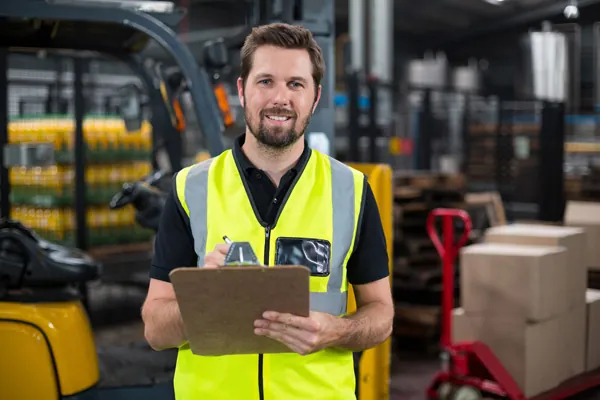
RFID vs Mobile Barcoding: What’s the Difference and Which Should You Use?
RFID and mobile barcoding both capture data automatically to improve accuracy, traceability, and speed across manufacturing, distribution, and field operations. RFID supports bulk, no-line-of-sight reads and can carry more data on-tag. Barcodes are inexpensive, universal, and easy to deploy across suppliers and facilities. In 2025, the real question is not either-or. It is which method fits each workflow, cost model, and performance target.
Two developments should shape your roadmap this year. First, large retailers and healthcare providers are preparing for 2D codes to be accepted at checkout and point of care by 2027. For a clear overview of why brands are moving beyond legacy UPC, read the Wall Street Journal’s report on the shift to 2D barcodes, which covers the packaging, hardware, and software changes required. Second, RFID’s role has matured in retail and logistics, especially for inventory accuracy and loss reduction. Retail Dive’s analysis of RFID’s expanding role in inventory and shrink explains how hands-free reads and item-level visibility are driving adoption.
Quick definitions
Mobile barcoding combines 1D or 2D labels with handheld computers or smartphones running real-time apps that talk directly to your ERP. The goal is simple: scan at the point of work, eliminate paper, and keep system data current. For a clear primer on how this fits into warehouse, manufacturing, and field operations, see mobile barcoding software.
RFID uses small tags with chips and antennas. Readers energize the tags and receive backscattered signals containing the tag’s data. Most supply chain deployments rely on UHF RAIN RFID for item-level tracking, work-in-process visibility, and fixed-reader portals at dock doors or conveyors.
RFID and mobile barcoding at a glance
| Factor | Mobile Barcoding | RFID (UHF RAIN) |
|---|---|---|
| Read behavior | Line of sight with item-by-item scans | No line of sight with bulk reads in a defined zone |
| Typical range | Contact to several feet | Inches to many feet, depending on tag and antenna |
| Speed | High for single-item workflows | Very high for many items moving through a portal |
| Media cost | Very low per printed label | Higher per tag, especially for durable or on-metal |
| Data capacity | From ID only to rich 2D payloads | EPC plus optional user memory on the tag |
| Interference | Minimal across substrates | Sensitive to metal and liquids, mitigations available |
| Ideal use | Receiving, putaway, picking, packing, counts, QA | Asset tracking, WIP, dock portals, yard gates |
| Setup complexity | Low to moderate | Moderate to higher due to RF design and tuning |
| ERP integration | Mature, app-driven transactions | Same transactions can ingest RFID read events |
Note on interference. Metal and liquids can detune UHF RFID and reduce read range. Proper tag choice, antenna geometry, and tag placement usually mitigate this, but you need to validate in your environment.
What changed since 2020 and why it matters now
2D is moving from plan to practice. Sunrise 2027 means more partners will expect 2D symbols that carry richer data. The benefit for supply chain teams is that you can increase data density without changing your basic scanning approach. At the workflow level, 2D helps with recall readiness, date and lot capture, and direct links to cloud documentation, all while keeping line-of-sight scanning and low media cost.
RFID is an operations tool, not a novelty. Beyond apparel, retailers and brands are applying RFID to categories where inventory accuracy, cycle count speed, and hands-free verification produce measurable returns. In logistics, portals at dock doors and conveyors validate contents in motion, cutting touches and compressing dwell time. In manufacturing, RFID supports work-in-process tracking for subassemblies and returnable containers, improving genealogy and reducing search time.
Hybrid wins. Most enterprises standardize on barcodes across the board and add RFID where it pays. That is because barcode scanning remains the simplest, lowest-cost way to capture a correct transaction when an operator is already handling the item, while RFID removes touches in high-volume, high-speed, or hard-to-reach scenarios.
How they are similar
- Both are forms of automatic identification and data capture that reduce manual entry errors, increase traceability, and improve on-hand accuracy.
- Both run on rugged handhelds, wearables, vehicle-mount terminals, or fixed infrastructure.
- Both should post identical ERP transactions so users do not need to care whether the ID came from a scan or a read. A mobile platform such as RFgen MobileEdge enables this single-process approach across SAP, Oracle, and other ERPs, and this article mentions MobileEdge only here by design.
How they differ, with on-floor examples
Read behavior and speed. Barcodes require line of sight and are typically scanned one at a time. That works very well where the worker is already touching each item, such as piece-pick, pack, quality checks, and cycle counts. RFID shines when many items move through a zone or when you want unattended verification. A conveyor portal can validate a mixed carton automatically. A dock door read zone can confirm a pallet’s contents without opening it. A gate can inventory vehicles or returnable containers as they pass.
Environment. RFID performance depends on materials and spacing. Metal, dense liquids, and stacked packaging can reduce range or cause stray reads if the zone is not tuned. You can solve most issues with on-metal tags, near-field antennas, shielding, and thoughtful placement. Barcodes are broadly substrate-agnostic when label material and print are chosen correctly.
Data payloads. 2D barcodes close much of the gap for on-label payload by encoding batch, lot, serial, and dates and by linking to cloud content. RFID still has two distinct strengths: selective writes without line of sight and bulk reads for automated verification, which are valuable for WIP histories, toolroom transactions, and unattended gate reads.
Cost profile. Printed labels and handheld scanners have low entry cost and a fast path to value. RFID tags and read zones cost more and require RF design, tag commissioning, and testing. The ROI is strongest where labor savings, inventory accuracy, loss reduction, or customer compliance are material.
Real-world example. One automotive operation combined fixed RFID portals to validate vehicle flow with mobile scanning for exceptions and operator tasks. For a deep dive into a similar approach, review the Toyota RFID and mobile barcoding case study, which illustrates how fixed readers and handheld workflows complement each other in practice.
When to use RFID
Use RFID when one or more of the following applies:
- Bulk or hands-free reads are critical. Portals at dock doors, conveyors that validate mixed contents, and yard or gate reads that inventory assets in motion benefit from automated zones.
- High-value assets or WIP need continuous visibility. Toolrooms, molds, returnable containers, and subassemblies gain from accurate, unattended tracking and selective write capability.
- Customer or channel compliance requires tagging. If you sell into programs that mandate RFID for specific categories or packaging types, design your EPC encoding, tagging, and testing to spec.
- Ergonomics or safety limit handling. When items are awkward or unsafe to reach, non-line-of-sight reads reduce touches, injuries, and time.
Implementation notes for RFID. Treat RFID events like scans inside the same transactions. Pilot by environment, not just by use case. Validate tag placement, antenna geometry, power settings, and read zone boundaries. Define exception flows so operators can resolve mismatches with a handheld quickly.
When to use mobile barcoding
Choose mobile barcoding when you want:
- Speed with simplicity. One-scan, one-action workflows excel in receiving, putaway, picking, packing, shipping, and cycle counts.
- Universal compatibility across partners. Barcodes are the common language up and down the supply chain, which keeps supplier onboarding simple and reduces friction with customers.
- Low cost and rapid rollout. Labels, printers, and scanners are inexpensive and scalable. Training time is short once workers see the immediate feedback and error prevention.
- A clear path to 2D without RF complexity. If you want richer on-label data or cloud links, 2D lets you step up capability while keeping your scanning model intact. The Wall Street Journal overview above explains why many brands are adopting 2D now to be ready for 2027. The Wall Street Journal
Implementation notes for mobile barcoding. Standardize label content and symbologies. Use verification printing for critical labels so scans are successful the first time. Build short, task-specific screens that mirror the physical workflow so workers do not hunt for the next step. Align device selection to your environment, scanning range, and network coverage.
The hybrid reality
Most teams end up here:
- Barcodes for everything, RFID where it pays. Label all SKUs and containers to ensure every process can rely on a scan. Add RFID to assets, returnables, high-throughput lanes, or mandated categories where hands-free reads produce a clear return.
- Portals plus handhelds. Fixed readers handle flow in high-volume zones, while mobile scanning captures exceptions, rework, and audits.
- ERP-first architecture. Whether the identifier came from a barcode or an EPC tag, the posted transaction should look identical to users, supervisors, and auditors.
Implementation checklist
- Map use cases and KPIs. Target the steps that cause bottlenecks or errors. Common early wins include receiving verification, dock validation, cycle counts, and asset tracking. Define baseline metrics for accuracy, touches per task, and time per transaction.
- Choose your identifier strategy. Standardize 1D and 2D barcodes as the baseline across items, cases, and pallets. Add UHF RFID selectively for assets, returnables, or flow-through lanes where bulk reads or compliance justify the cost.
- Model total cost of ownership. Include media, devices, antennas, RF design, commissioning, mobile licenses, ERP integration, and change management. Compare barcode-only, RFID-only, and hybrid scenarios for CapEx and OpEx, then quantify labor and accuracy gains.
- Pilot in real conditions. For RFID, test tag placement, antenna geometry, reader power, and read zone boundaries with live product and packaging. For barcodes, validate label materials, print durability, scan angles, and lighting.
- Integrate once, use everywhere. Unify scans and reads through the same mobile transactions so training, exceptions, and auditing stay simple. Keep error messages plain and actionable so operators know exactly what to fix.
- Design labels and tags early. Align data fields, serial and lot encoding, and on-pack real estate so 2D and RFID can coexist without redesigning packaging later.
- Train for the human reality. Even with automation, people handle exceptions. Keep handhelds available for spot checks and rework, and track help-desk tickets to find workflow friction you can remove.
Frequently asked questions
Will RFID replace barcoding?
No. 2D barcodes raise the ceiling for what barcoding can do, while RFID addresses different needs such as hands-free verification and automated flow. Most enterprises will use both and choose per use case.
Do I need RFID if I sell to big-box retail?
It depends on your categories and customers. Some programs specify tagging for certain items. Others put more emphasis on 2D readiness by 2027. Confirm requirements early and design to spec.
Where does RFID deliver the fastest ROI?
Anywhere bulk verification replaces manual scans, where asset shrink is costly, or where compliance and safety make missed scans unacceptable. Retail case studies consistently tie RFID to better on-hand accuracy and fewer touches, themes highlighted in the Retail Dive piece above. Retail Dive
What about device strategy for scanning and reading?
Match devices to the job. Long-range scanning helps on high bays. Wearables help when hands stay busy. For RFID, choose reader and antenna combinations that fit your portal geometry and packaging mix, then tune power and placement during pilot.
Bottom line
- Use mobile barcoding for most day-to-day transactions because it is cost-efficient, fast to roll out, and universally understood.
- Layer RFID where bulk reads, automation, ergonomics, or customer mandates justify the added investment.
- Keep the experience ERP-first so users follow one process regardless of capture method. Start by aligning your baseline scanning approach with mobile barcoding software, study a blended deployment in the Toyota RFID and mobile barcoding case study, and evaluate integration using RFgen MobileEdge once to confirm your end-to-end flow.






